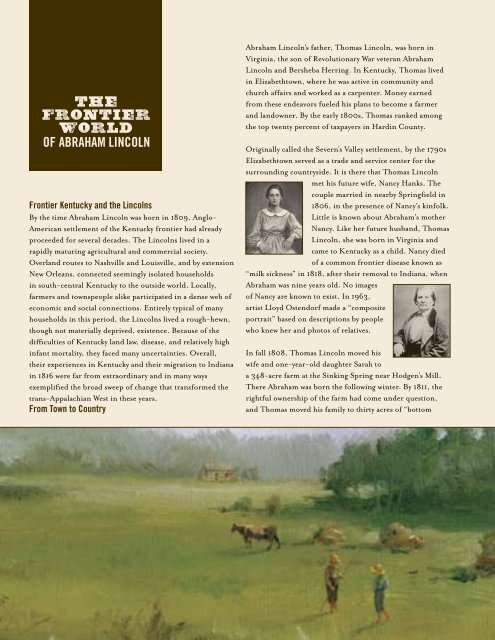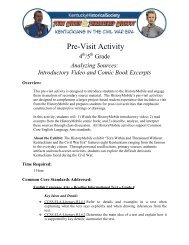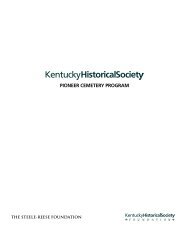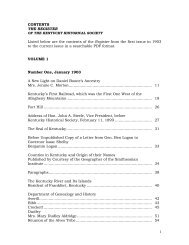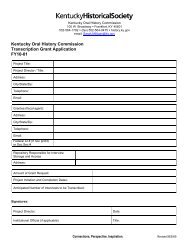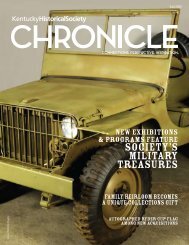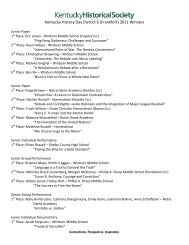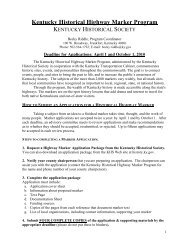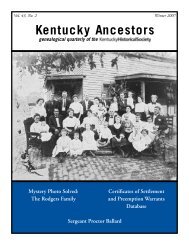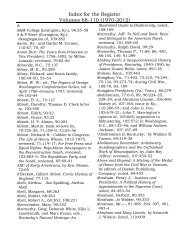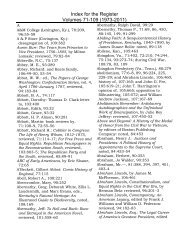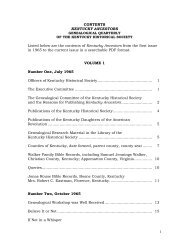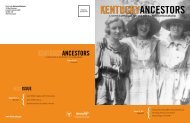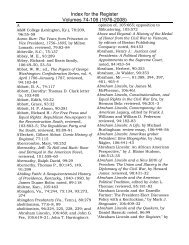Chronicle Fall 2008 Lincoln insert - Kentucky Historical Society
Chronicle Fall 2008 Lincoln insert - Kentucky Historical Society
Chronicle Fall 2008 Lincoln insert - Kentucky Historical Society
You also want an ePaper? Increase the reach of your titles
YUMPU automatically turns print PDFs into web optimized ePapers that Google loves.
Frontier <strong>Kentucky</strong> and the <strong>Lincoln</strong>s<br />
By the time Abraham <strong>Lincoln</strong> was born in 1809, Anglo-<br />
American settlement of the <strong>Kentucky</strong> frontier had already<br />
proceeded for several decades. The <strong>Lincoln</strong>s lived in a<br />
rapidly maturing agricultural and commercial society.<br />
Overland routes to Nashville and Louisville, and by extension<br />
New Orleans, connected seemingly isolated households<br />
in south-central <strong>Kentucky</strong> to the outside world. Locally,<br />
farmers and townspeople alike participated in a dense web of<br />
economic and social connections. Entirely typical of many<br />
households in this period, the <strong>Lincoln</strong>s lived a rough-hewn,<br />
though not materially deprived, existence. Because of the<br />
difficulties of <strong>Kentucky</strong> land law, disease, and relatively high<br />
infant mortality, they faced many uncertainties. Overall,<br />
their experiences in <strong>Kentucky</strong> and their migration to Indiana<br />
in 1816 were far from extraordinary and in many ways<br />
exemplified the broad sweep of change that transformed the<br />
trans-Appalachian West in these years.<br />
From Town to Country<br />
Abraham <strong>Lincoln</strong>’s father, Thomas <strong>Lincoln</strong>, was born in<br />
Virginia, the son of Revolutionary War veteran Abraham<br />
<strong>Lincoln</strong> and Bersheba Herring. In <strong>Kentucky</strong>, Thomas lived<br />
in Elizabethtown, where he was active in community and<br />
church affairs and worked as a carpenter. Money earned<br />
from these endeavors fueled his plans to become a farmer<br />
and landowner. By the early 1800s, Thomas ranked among<br />
the top twenty percent of taxpayers in Hardin County.<br />
Originally called the Severn’s Valley settlement, by the 1790s<br />
Elizabethtown served as a trade and service center for the<br />
surrounding countryside. It is there that Thomas <strong>Lincoln</strong><br />
met his future wife, Nancy Hanks. The<br />
couple married in nearby Springfield in<br />
1806, in the presence of Nancy’s kinfolk.<br />
Little is known about Abraham’s mother<br />
Nancy. Like her future husband, Thomas<br />
<strong>Lincoln</strong>, she was born in Virginia and<br />
came to <strong>Kentucky</strong> as a child. Nancy died<br />
of a common frontier disease known as<br />
“milk sickness” in 1818, after their removal to Indiana, when<br />
Abraham was nine years old. No images<br />
of Nancy are known to exist. In 1963,<br />
artist Lloyd Ostendorf made a “composite<br />
portrait” based on descriptions by people<br />
who knew her and photos of relatives.<br />
In fall 1808, Thomas <strong>Lincoln</strong> moved his<br />
wife and one-year-old daughter Sarah to<br />
a 348-acre farm at the Sinking Spring near Hodgen’s Mill.<br />
There Abraham was born the following winter. By 1811, the<br />
rightful ownership of the farm had come under question,<br />
and Thomas moved his family to thirty acres of “bottom


